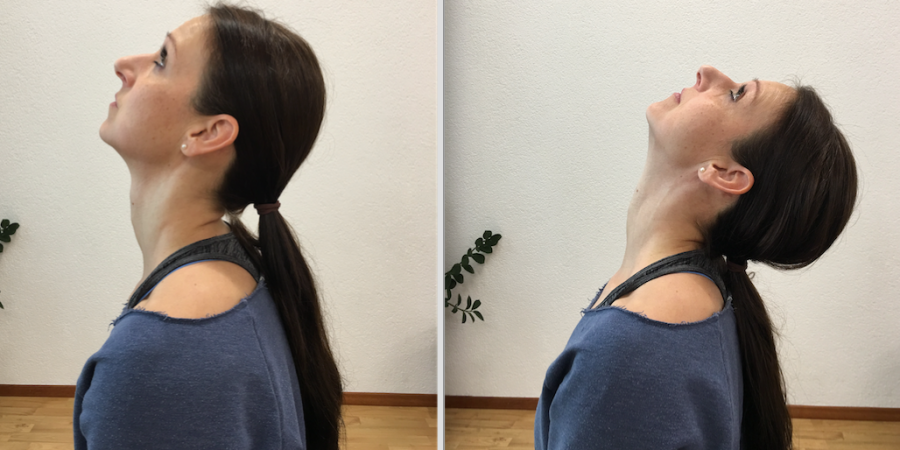A common observation with clients is the forward head posture (FHP). A neutral head posture is very important for the client, especially when it comes to exercising. To execute an exercise the right way it is important that his or her execution is good. And to have good execution of an exercise you need to have good posture in that exercise. The best way to get there is to first fix the static posture (standing/seated). Then you execute the exercise – which is dynamic posture.
Common findings with the FHP is the so called upper cross syndrome = weak/ inhibited neck flexors
Following muscles are probably facilitated or have restrictions
– Sternocleidomastoideus muscle
– Scalene muscles
– Levator Scapulae muscle
– Suboccipital muscles
Scalene muscles and suboccipital muscles which are adapted short with a high tonus due to the FHP will inhibit the deep neck flexors.
The scalene muscles insert in rib 1 and rib 2 and a very common finding is that rib 1 is superior and cannot move in the inferior direction and this way just the first rip in its self can give symptoms to the arms/fingers restrict the motion of the neck and shoulders. The suboccipital muscles adapt to this by getting short.
Now there are studies that show that one of the suboccipital muscles (Rectus capitis posterior minor) has a connection with the dura (the wrapping of the spinal cord). There are two possible mechanisms that can give neurological dysfunction:
1. Direct mechanical insult on the nerve from the spinal cord
2. Collapse of the small veins close to the spinal cord / congestion of the small veins
If you look on the cross section of the spinal cord at the level of the first vertebra (atlas) you can see two big tracts – that are the spinocerebellar tract and the spinothalamic tract.
The first system can be influenced by traction and/or compression of the dentate ligaments.
It is in this system where the signals travel that decide the tonus of the muscle and which also send information of the joint position (proprioception).
In the outer fibers of this tract are the “cables” that go to the lower part of the body, to the
pelvis, hip, legs and feet. If you have dysfunction and/or imbalance in the in upper cervical region this can cause symptoms in the legs.
The second system, the spinothalamic tract, is also effected by the position/ posture of the neck. In this tract the signals that are send are for nociception/ temperature. This is a possible explanation for symptoms down the legs without any findings from the lumbar spine/ pelvis or legs. That can potentially be corrected by treating the upper cervical region and posture of the neck.
Some effects of the forward head posture are:
– traction of the supra scapular nerve (this nerve is the innervation to the supraspinatus muscle and the infraspinatus muscle)
– usually a traction of a peripheral nerve leads to inhibition of the muscles innervated by that peripheral nerve
A Dowagers hump is a sign of chronic FHP. This creates a dysfunction in the cervical-thoracic junction. This stresses the ligaments between the vertebra and to some extend the capsules of the thoracic vertebras. With the tightness in the ligaments there is often a tightness and increased tonus in the upper thoracic extensors.
For very 2,5 cm of FHP the compression in the lower cervicals increases with the equivalent of an extra head. Considering that the weight of the head is approximately 7% of bodyweight (BW) and a forward rotated shoulder girdle is approximately 14% of BW, a total 21% of BW can give compression in the lower cervical and upper thoracic spine.
This is something to consider when doing RDLs, Snatches, Deadlifts etc., because you will have 21% of BW and an external load ”hanging” on your neck and upper thoracics.
This is extra important for women, since women in general only have 60% of a mans neck extensor strength.
You can also get entrapment of the greater suboccipital nerve high up in the suboccipital region. This often shows up as a headache.
Dysfunction of Th1-Th4 (upper thoracic). This area is the home of the sympathetic nervous system and it controls the tonus of the vessels for the neck, shoulders, arms and hands. This is very important for exchange of nutrition metabolites etc. or in headaches, where we often have tonus of the vessels as a possible background to the symptoms.
This can also be important in acute injuries with swelling to normalize the swelling by treating the nervous system.
To learn how loosen up tight muscles and strengthen weak muscle to improve FHP sign up for the YPSI MyoRelease for Personaltrainers Seminar in Brussels, Belgium in March 2017. Where you will learn various Techniques to Improve Mobility, Flexibility and Stability as well as how to use the YPSI Tool.
Picture: Great Before`n`After of Swiss Personaltrainer Nadja Reinmann improving neckextension after a treament with Dr. Peter Lundgren..

